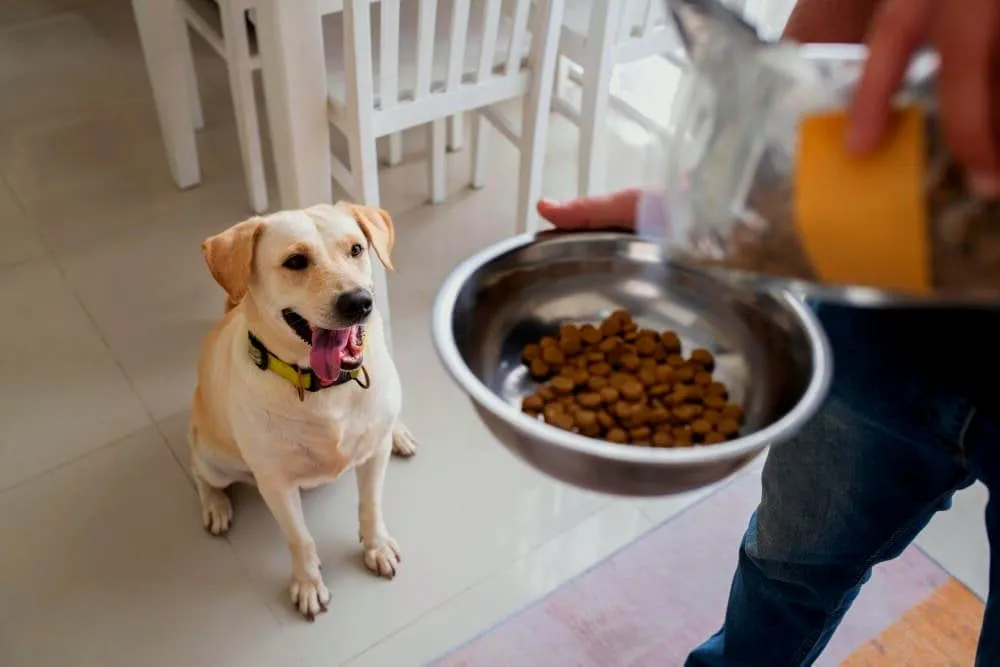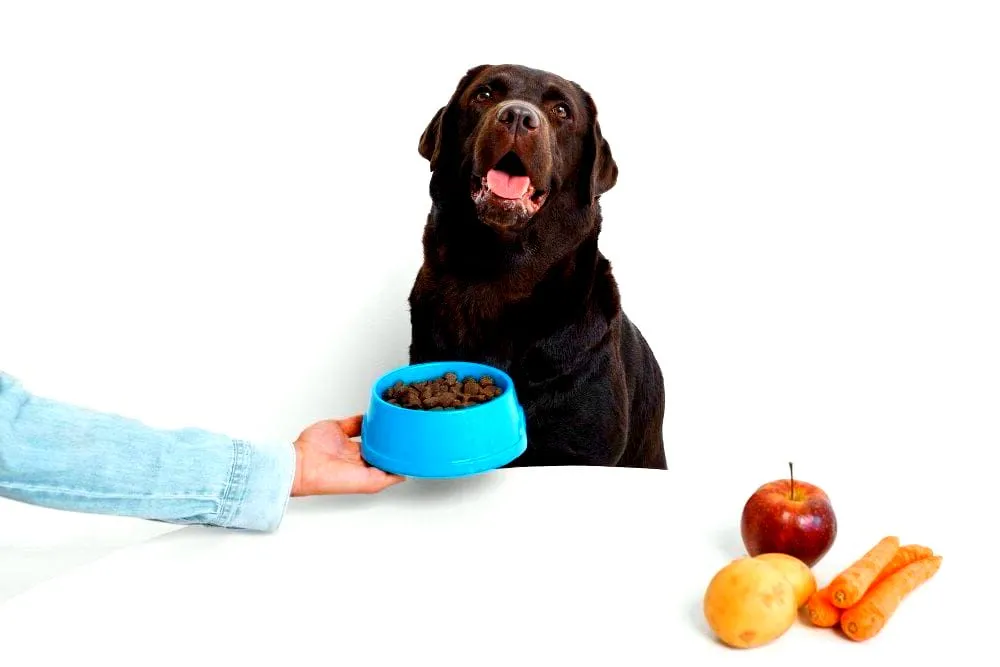
Your adult dog should be fed two meals a day to maintain a healthy diet. Feeding your adult dog the right amount of food at regular intervals is essential for its overall well-being.
A balanced diet plays a crucial role in keeping your furry friend active, maintaining a healthy weight, and preventing health issues.
While it’s important to consult your veterinarian for specific feeding guidelines based on your dog’s breed, size, and activity level, a generally recommended practice is to feed adult dogs twice a day.
This helps to ensure that your dog receives the necessary nutrients and energy it needs throughout the day. Consistency in meal times also helps in establishing a routine and aids in digestion.
In the following sections, we will dive deeper into why feeding your adult dog twice a day is beneficial and discuss some important factors to consider while determining the quantity of food to be served.
How Much Should Adult Dogs Eat?
Feeding your adult dog the right amount of food is crucial for their health. It is recommended to feed them twice a day, following the serving size guidelines provided by their specific dog food brand.
Feeding your adult dog the right amount of food is crucial for their overall health and well-being. The amount of food they require can vary depending on several factors, such as their size, age, activity level, and metabolism. Here’s what you need to know about how much adult dogs should eat:
- Consult your veterinarian: Before determining the appropriate amount of food for your adult dog, it’s always best to consult with your veterinarian. They will consider your dog’s specific needs and recommend the right portion size.
- Follow feeding guidelines: Most commercial dog food brands provide feeding guidelines on their packaging. These guidelines usually suggest a range of recommended serving sizes based on your dog’s weight. Start with the lower end of the range and adjust as necessary. Keep in mind that these guidelines are just a starting point and may need to be adjusted based on your dog’s individual needs.
- Monitor your dog’s body weight: Regularly monitor your dog’s body weight to ensure they are maintaining a healthy weight. If your dog begins to gain weight, you may need to reduce their food intake. Conversely, if they are losing weight or appear too thin, you may need to increase their food portion.
- Consider your dog’s activity level: Dogs that are more active or have high energy levels may require more food to meet their nutritional needs. On the other hand, less active dogs or those with a sedentary lifestyle may require fewer calories.
- Divide meals into portions: It’s usually best to divide your dog’s daily food intake into two or three smaller meals throughout the day. This can help prevent overeating and aid in proper digestion.
- Observe for signs of hunger or fullness: Pay attention to your dog’s behavior around feeding time. If they are consistently leaving food in their bowl or seem uninterested in eating, they may not be hungry. On the other hand, if they are constantly begging for food or appear overweight, they may be getting too much food.
- Avoid overfeeding: While it may be tempting to give your dog extra treats or table scraps, it’s essential to avoid overfeeding. Excess weight gain can lead to numerous health issues, including obesity, joint problems, and reduced lifespan.
- Adjust as your dog ages: As your dog ages, their metabolism may slow down, and their activity levels may decrease. It’s important to reassess their food portion size and make adjustments accordingly to prevent weight gain.
- Consider the quality of food: The quality of the dog food you choose can also impact the amount you feed your adult dog. High-quality foods are often more nutrient-dense, meaning your dog may require less food to meet their nutritional needs compared to lower-quality options.
- Be mindful of breed-specific needs: Some dog breeds have specific dietary requirements or may be prone to certain health issues. For example, large breed dogs may have different feeding guidelines compared to small breed dogs. Familiarize yourself with any breed-specific recommendations to ensure you are providing the appropriate amount of food.
Remember, finding the right balance in your adult dog’s diet is essential. Regularly assess their body condition and consult with your veterinarian to provide them with the appropriate amount of food for their specific needs.
What Affects How Often A Dog Should Eat?
The frequency at which an adult dog should be fed depends on factors such as breed, size, age, and activity level.
It is generally recommended to feed them twice a day with a balanced diet formulated for adult dogs to maintain their overall health and well-being.
Certain factors can influence how often you should feed your adult dog. Understanding these factors can help ensure that your furry friend receives the appropriate amount of food each day. The following are some important things to remember:
- Breed and Size: Different dog breeds have unique nutritional needs and metabolisms. Larger breeds tend to have slower metabolisms and may require less frequent meals, while smaller breeds may need to eat more often due to their faster metabolisms.
- Age: Puppies have higher energy requirements and typically need to eat more frequently than adult dogs. As dogs mature, their nutritional needs change, and they may require fewer meals per day.
- Activity Level: Active and working dogs burn more calories and may need to eat more frequently to fuel their energy needs. On the other hand, sedentary or less active dogs may require fewer meals to maintain a healthy weight.
- Health Conditions: Certain medical conditions, such as diabetes or gastrointestinal disorders, may require specific feeding schedules. It’s essential to consult with your veterinarian for personalized guidance and advice.
- Weight and Body Condition: A dog’s weight and body condition play a crucial role in determining their feeding frequency. Dogs that are underweight may benefit from more frequent meals, while overweight dogs may require fewer meals and carefully portioned servings.
- Feeding Method: Different feeding methods, such as free feeding or scheduled meals, can impact how often your dog should eat. Free feeding allows dogs to graze throughout the day, while scheduled meals involve feeding specific portions at set times.
- Preference and Behavior: Some dogs may have unique feeding preferences or specific dietary needs. It’s important to observe your dog’s eating habits and adjust their feeding schedule accordingly.
Remember, it is always best to consult with your veterinarian to develop a feeding plan tailored to your dog’s individual needs. Following their expert guidance will help ensure your adult dog remains healthy and well-nourished.
Control Portions
Feeding your adult dog in controlled portions is essential for their overall health. It is recommended to feed them regularly, dividing their meals into two to three portions a day.
Properly controlling the portions of food you feed your adult dog is essential for maintaining their overall health and weight. Here are some key points to consider:
- Keeping an eye on calorie intake: It’s important to ensure that your dog is consuming the appropriate number of calories each day to prevent weight gain or loss. Consult with your veterinarian to determine the ideal calorie intake for your dog based on factors such as age, size, activity level, and overall health.
- Measuring your dog’s food: Using a measuring cup or scale to measure your dog’s food can help you accurately control their portion sizes. This avoids overfeeding, which can lead to obesity, as well as underfeeding, which can result in nutritional deficiencies.
- Dividing meals: Splitting your dog’s daily food allowance into multiple small meals can have several benefits. It helps in better digestion and absorption of nutrients, reduces the chances of bloating or gastric issues, and can prevent your dog from feeling overly hungry or scavenging for food during the day.
- Adjusting portion sizes: Keep an eye on your dog’s weight and body condition to determine if their portion sizes need adjustment. If your dog is gaining or losing weight, consult with your veterinarian before making any changes to their food amounts.
- Monitoring treats and extras: Treats can add extra calories to your dog’s diet rapidly, so it’s crucial to monitor the number and size of treats you give. It’s often recommended to account for treats in your dog’s daily calorie intake and adjust their main meals accordingly.
- Avoiding free-feeding: Leaving food out all day for your dog to graze can make it difficult to control their portion sizes. Implementing a regular feeding schedule can help you better manage their food intake.
- Consulting your veterinarian: Your veterinarian is your best resource for determining the appropriate portion sizes for your dog. They can consider your dog’s individual needs and provide personalized recommendations for controlling portions effectively.
Remember, controlling your dog’s portions is key to maintaining a healthy weight and preventing potential health issues.
Regularly monitoring their body condition and seeking guidance from your veterinarian will help ensure your dog’s portion sizes are appropriate for their overall well-being.
Watch The Clock
Wondering how often to feed your adult dog? Watch the clock! Stick to a strict feeding schedule to keep your pup healthy and satisfied.
Feeding your adult dog is an essential part of their overall health and well-being. But how often should you feed them?
Finding the right feeding schedule for your furry friend can be a bit challenging, as it depends on various factors such as their age, size, breed, and activity level.
In this section, we’ll explore some guidelines to help you determine the ideal feeding frequency for your adult dog.
Factors To Consider:
When deciding on a feeding schedule for your adult dog, it’s crucial to take several factors into account. Here are some things to bear in mind:
- Age: Adult dogs have different nutritional requirements compared to puppies or senior dogs. Their age will help determine how often they should be fed.
- Size and Breed: Larger dog breeds often have different metabolic rates and growth patterns compared to small or medium-sized breeds. Consider your dog’s size and breed when determining their feeding schedule.
- Activity Level: How active your dog is throughout the day can impact their calorie intake. More active dogs may require more frequent feeding to meet their energy needs.
- Health Conditions: Some dogs may have specific health conditions that require a tailored feeding schedule. Consulting with your veterinarian can help determine the best approach for your dog’s unique needs.
General Guidelines:
Now that we’ve covered the key factors to consider, let’s outline some general guidelines for feeding your adult dog:
- Most adult dogs thrive on being fed twice a day, with a twelve-hour gap between each meal. This helps maintain a consistent routine and prevents hunger between meals.
- Pay attention to your dog’s weight and overall health. If they start gaining excess weight or becoming overweight, you may need to adjust their feeding schedule and portion sizes.
- Avoid leaving food out all day. Free-feeding can make it difficult to monitor your dog’s caloric intake and can lead to overeating.
- Setting up and keeping to a feeding plan is crucial.
Recall that each dog is different and may have different demands.Here are some key considerations to keep in mind: Consistency is key in maintaining your dog’s digestive health and preventing potential behavioral issues. - If you have concerns or specific dietary requirements for your dog, consulting with a veterinarian or canine nutritionist can provide tailored advice for your pet’s needs.
Remember, every dog is unique, and their individual needs may vary. Finding the right feeding schedule may take some trial and error, but with a bit of observation and care, you can ensure your adult dog receives the nutrition they need to thrive.
Let Your Dog Decide
Discover the best feeding frequency for your adult dog with “Let Your Dog Decide. ” This informative guide provides insights into maintaining your dog’s health with personalized feeding schedules.
Many dog owners wonder how often they should feed their adult dogs. The answer may vary depending on various factors such as their dog’s age, breed, size, and activity level. Instead of relying on strict schedules or generic guidelines, it is often best to let your dog’s natural appetite and behavior guide you.
By observing your dog’s signals and adjusting their feeding routine accordingly, you can ensure they are getting the appropriate amount of food. The following are some important things to remember:
Observe Your Dog’s Appetite And Energy Level
- Pay attention to your dog’s appetite and energy level throughout the day.
- Observe if they are eager and excited for meals or if they seem disinterested.
- Notice if they are maintaining a healthy weight or showing signs of excessive hunger or weight gain.
Monitor Their Body Condition
- Regularly assess your dog’s body condition by feeling their ribs.
- A healthy weight should allow you to feel their ribs without the need for excessive pressure.
- If you can’t feel their ribs at all, your dog may be overweight, while if the ribs are highly visible, they may be underweight.
Consider Their Daily Activity
- Take your dog’s daily activity level into account when determining their feeding schedule.
- More active dogs may require more frequent and larger meals to maintain their energy levels.
- Less active or senior dogs may benefit from smaller, less frequent meals to avoid weight gain.
Establish A Consistent Feeding Routine
- Dogs thrive on routine, so try to establish a consistent feeding schedule.
- Provide meals at the same time each day, which can help regulate their metabolism.
- Avoid leaving food out all day as it may lead to overeating or irregular eating patterns.
Adapt To Individual Needs
- Every dog is unique, so it’s essential to adapt their feeding routine to their individual needs.
- If your dog has any specific dietary requirements or health concerns, consult with a veterinarian.
- Monitor their weight and overall well-being regularly to ensure you’re meeting their nutritional needs.
Remember, while these guidelines can provide a starting point, it’s crucial to personalize your dog’s feeding routine based on their signals and behavior. By letting your dog decide the frequency and amount of food they need, you can ensure they remain healthy and satisfied.
They Look Great But Are Always Hungry
Feeding your adult dog depends on their specific needs, but it’s important to strike a balance to keep them satisfied. Listen to their cues and establish a consistent feeding schedule to keep them healthy and happy.
Many dog owners often find themselves in a predicament – their adult dogs look great and healthy, but they seem to be constantly hungry. If you’re experiencing this with your furry friend, finding the right feeding schedule can make all the difference.
Here’s a look at how often you should feed your adult dog to keep them satisfied and satisfied:
Feeding Frequency:
- Twice a day: Most adult dogs thrive on a feeding schedule that includes two meals per day, one in the morning and one in the evening. This regular feeding routine helps your dog maintain a steady energy level and avoids prolonged periods of hunger.
- Consider portion control: If your dog is always hungry despite being on a regular feeding schedule, it’s worth reassessing the quantity of food you’re providing. Ensure you’re giving your dog an adequate portion size that meets their nutritional needs.
- Stick to a schedule: Dogs are creatures of habit, and having a consistent feeding routine can help regulate their hunger. Aim to feed your adult dog at the same times every day, as this will make them more aware of when to expect their meals.
- Avoid frequent grazing: Leaving food out all day or allowing your dog to graze throughout the day can contribute to the constant hunger they might experience. Instead, maintain a structured mealtime and remove any uneaten food after a set period, usually 20-30 minutes.
Active Lifestyle:
- Consider your dog’s activity level: If your dog is highly active or engages in regular exercise, they may require more frequent feedings to sustain their energy levels. Dogs that have more physical activity burn calories quicker, and spreading their meals throughout the day can help prevent excessive hunger.
- Monitor your dog’s body condition: Regularly assess your dog’s weight and body condition to determine if they need adjustments in their feeding schedule. While they may always appear hungry, it’s essential to maintain their weight within a healthy range to avoid potential health issues.
- Consult a veterinarian: If you’re unsure about how often to feed your adult dog or concerned about their constant hunger, consult with your veterinarian. Based on your dog’s breed, age, weight, and general health, they can offer specific advise.
By following the appropriate feeding schedule based on your dog’s needs and lifestyle, you can help alleviate their constant hunger and ensure they maintain a healthy weight.
Remember, a well-fed and satisfied dog is a happy companion ready to enjoy all the adventures by your side.
What About Treats?
Feeding your adult dog treats should be done in moderation to maintain a healthy diet. It’s important to consider the size and activity level of your dog, but generally, offering treats a few times a week is sufficient.
When it comes to feeding your adult dog, it’s essential to consider not only their main meals but also their treats. Treats can be a great way to reward your pup or use for training purposes.
However, it’s important to strike a balance and ensure that your dog’s overall diet remains healthy and well-balanced.
Here are some points to keep in mind when it comes to treats for your adult dog:
- Treats should make up no more than 10% of your dog’s daily caloric intake. This ensures that their main meals provide the necessary nutrients they need.
- Selecting quality snacks designed especially for dogs is crucial. Avoid human foods, especially those that can be toxic to dogs, like chocolate, grapes, and onions.
- Look for treats that are low in fat, sugar, and sodium. This helps prevent weight gain and keeps your dog’s overall health in check.
- When choosing rewards, take your dog’s breed and size into account. Certain treats could be too big or too firm for your dog to comfortably chew on.
- Treats that promote dental health, such as dental chews or toys, can be a great addition to your dog’s treat rotation. These can help keep their teeth clean and gums healthy.
Recall that when it comes to treats, moderation is crucial. Treats should be given as rewards or occasional indulgences, rather than being a substantial part of your dog’s daily diet. By being mindful of the treats you give and their frequency, you can ensure your adult dog stays healthy and happy.
What Sort Of Feeding Schedule Works?
The feeding schedule for adult dogs depends on their size, breed, and activity level. Generally, it is recommended to feed them two meals a day, with portion sizes according to their dietary needs. Regular feeding times help establish a routine and maintain their overall health.
Determining the appropriate feeding schedule for your adult dog is essential to help maintain their health and well-being.
While there is no one-size-fits-all answer, there are some general guidelines that can help you establish an effective feeding routine. Here are some factors to consider when deciding on a feeding schedule for your furry friend:
- Age, activity level, and size: Different dogs have different nutritional requirements based on their age, activity level, and size. Puppies, for example, typically require more frequent feeding than adult dogs. Similarly, highly active dogs may need more frequent meals compared to those with a more sedentary lifestyle.
- Type of food: The type of food you feed your dog can influence their feeding schedule. For instance, if you feed your dog dry kibble, you may choose to divide their daily intake into two meals. Wet food, on the other hand, may require more frequent feedings due to its higher moisture content.
- Health considerations: Some dogs may have health conditions that necessitate a specific feeding schedule. For example, dogs with diabetes may require scheduled meals to manage their blood sugar levels effectively. Consulting with your veterinarian can help you determine the best feeding schedule for dogs with specific health needs.
- Establishing routine: Dogs thrive on routine, so having a consistent feeding schedule can be beneficial. Try to feed your dog at the same times each day, which can help regulate their digestion and prevent unnecessary hunger or overeating.
- Free-feeding vs. Portion control: Free-feeding refers to leaving food available at all times, while portion control involves measuring your dog’s daily intake and dividing it into designated meals. While free-feeding can work for some dogs, it may not be suitable for those prone to weight gain. Portion control helps ensure your dog receives the appropriate amount of food and can aid in weight management.
- Monitoring body condition: Regularly monitoring your dog’s body condition can help you determine if their feeding schedule is appropriate. If they are gaining weight or becoming overweight, you may need to adjust their feeding frequency and portion size accordingly.
Establishing the right feeding schedule for your adult dog requires considering their individual needs, preferences, and overall health. Remember to consult with your veterinarian to tailor a feeding routine that best suits your dog’s specific requirements.
By providing a consistent, balanced, and appropriate feeding schedule, you can help promote their overall well-being and keep them healthy for years to come.
FAQs For How Often Should You Feed Your Adult Dog
Is It Ok To Feed Your Dog Once A Day?
Feeding your dog once a day is generally not recommended. Dogs benefit from smaller, more frequent meals to maintain stable blood sugar levels and prevent digestive issues.
Consult with a vet to determine the best feeding schedule for your dog’s specific needs.
How Much Should An Adult Dog Eat?
An adult dog should eat according to its weight, activity level, and specific dietary needs. It’s best to consult with a veterinarian to determine the right amount of food to feed your dog. They can provide personalized recommendations to keep your furry friend healthy and satisfied.
Is It Ok To Leave Dry Dog Food Out All Day?
Leaving dry dog food out all day is generally not recommended. It can spoil and attract pests. It’s best to follow the feeding guidelines provided by the manufacturer and establish a regular feeding schedule for your dog’s health and well-being.
How Often Should You Feed Your Dog By Age?
Puppies need to be fed multiple times a day, with three to four meals until they’re four months old. At four to six months, you can reduce to two to three meals, and at six months, you can typically switch to two meals a day.
Dogs that are adults often survive on two meals every day.
A Final Word
The frequency of feeding your adult dog depends on various factors such as their breed, size, age, and activity level. It is essential to provide them with a balanced and nutritious diet that meets their specific needs.
Consulting with a veterinarian and establishing a feeding schedule tailored to your dog’s requirements can ensure their overall health and well-being.
Remember, a well-fed dog is a happy and healthy companion.








